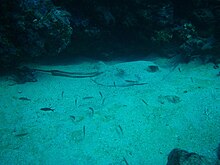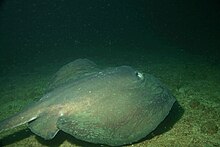Diamond stingray
| Diamond stingray | |
|---|---|

| |
| Scientific classification | |
| Domain: | Eukaryota |
| Kingdom: | Animalia |
| Phylum: | Chordata |
| Class: | Chondrichthyes |
| Subclass: | Elasmobranchii |
| Superorder: | Batoidea |
| Order: | Myliobatiformes |
| Family: | Dasyatidae |
| Subfamily: | Dasyatinae |
| Genus: | Hypanus |
| Species: | H. dipterurus
|
| Binomial name | |
| Hypanus dipterurus (D. S. Jordan & C. H. Gilbert, 1880)
| |

| |
| Range of the diamond stingray | |
| Synonyms | |
| |
The diamond stingray (Hypanus dipterurus) is a
When searching for food, diamond stingrays may form groups of up to hundreds of individuals. It is most active at night and preys mainly on burrowing
Taxonomy and phylogeny
In 1880, the diamond stingray was described twice by three American
The species
Distribution and habitat

The diamond stingray is found in the eastern
A
Description

The diamond stingray attains a disc width of 1 m (3.3 ft) or possibly 1.2 m (3.9 ft); females grow larger than males.
The whip-like tail generally measures up to one and half times the length of the disc, and bears one (more if replacements have grown in) long, slender, serrated spine on the upper surface, closer to the base than the tip.[6][10][12] Behind the spine, there are long dorsal and ventral fin folds that rise gradually, reaching a relatively high apex before sloping down abruptly.[7] The presence of the upper fin fold separates this species from the similar longtail stingray (D. longa), which shares most of its range. However, the tail is often damaged, in which case differentiating the two species in the field becomes all but impossible.[13] Young rays have completely smooth skin, while adults develop a row of low tubercles along the midline of the back, flanked by two shorter rows on the "shoulders". The tail also becomes covered in prickles.[11] This species is a uniform olive to brown to gray above, darkening to black on the tail, and off-white below.[6][13]
Biology and ecology

The diamond stingray is most active at night, spending much of the day buried in sand with only its eyes protruding. When foraging for food, it may be solitary but more commonly forms groups numbering up to the hundreds. There is strong segregation by sex and age. This species feeds on
The typical hunting strategy of the diamond stingray is to cruise just above the
Like other stingrays, the diamond stingray is
Human interactions
At least one fatality off southern California has resulted from the long, venomous tail spine of the diamond stingray. However, it is not aggressive and will usually flee given the opportunity. This ray is not found off the United States in sufficient numbers to be economically important. Elsewhere in its range, it is caught in substantial numbers for human consumption, both intentionally and as bycatch; the pectoral fins or "wings" are sold fresh or filleted and salted.[6] The International Union for Conservation of Nature (IUCN) notes that the diamond stingray's low reproductive productivity renders it susceptible to population depletion, and assesses it as Vulnerable overall.[1]
In
References
- ^ . Retrieved 16 November 2021.
- .
- ^ Garman, S. (October 1880). "New species of selachians in the museum collection". Bulletin of the Museum of Comparative Zoology. 6 (11): 167–172.
- .
- ^ a b Eschmeyer, W. N. (ed.) dipterurus, Dasybatus Archived 2012-02-21 at the Wayback Machine. Catalog of Fishes electronic version (February 19, 2010). Retrieved on March 25, 2010.
- ^ ISBN 0-520-23484-7.
- ^ a b c Nishida, K. and K. Nakaya (1990). "Taxonomy of the genus Dasyatis (Elasmobranchii, Dasyatididae) from the North Pacific." in Pratt, H.L., S.H. Gruber and T. Taniuchi. Elasmobranchs as living resources: advances in the biology, ecology, systematics, and behaviour, and the status of fisheries. NOAA Technical Report, NMFS 90. pp. 327–346.
- S2CID 85657403.
- ^ Froese, Rainer; Pauly, Daniel (eds.) (2023). "Hypanus dipterurus" in FishBase. July 2023 version.
- ^ ISBN 0-618-00212-X.
- ^ a b Jordan, D.S.; B.W. Evermann (1896). The Fishes of North and Middle America (Part 1). Government Printing Office. p. 85.
- ISBN 0-8050-0733-4.
- ^ ISBN 0-8047-2289-7.
- JSTOR 1445875.
- S2CID 43915565.
- S2CID 7438797.
- S2CID 83700913.
- PMID 17285847.
- ISBN 2-914518-36-6.
- PMID 13295894.
- S2CID 37124160.
- ^ doi:10.1071/MF06083.
External links
- Dasyatis dipterura, Diamond stingray at FishBase
- Pollom, R.; Bizzarro, J.; Burgos-Vázquez, M.I.; Cevallos, A.; Velez-Zuazo, X.; Avalos, C.; Espinoza, M.; González, A.; Herman, K.; Mejía-Falla, P.A.; Navia, A.F.; Pérez Jiménez, J.C.; Sosa-Nishizaki, O. (2020). "Hypanus dipterurus". . Retrieved 16 November 2021.
- Photos of Diamond stingray on Sealife Collection

